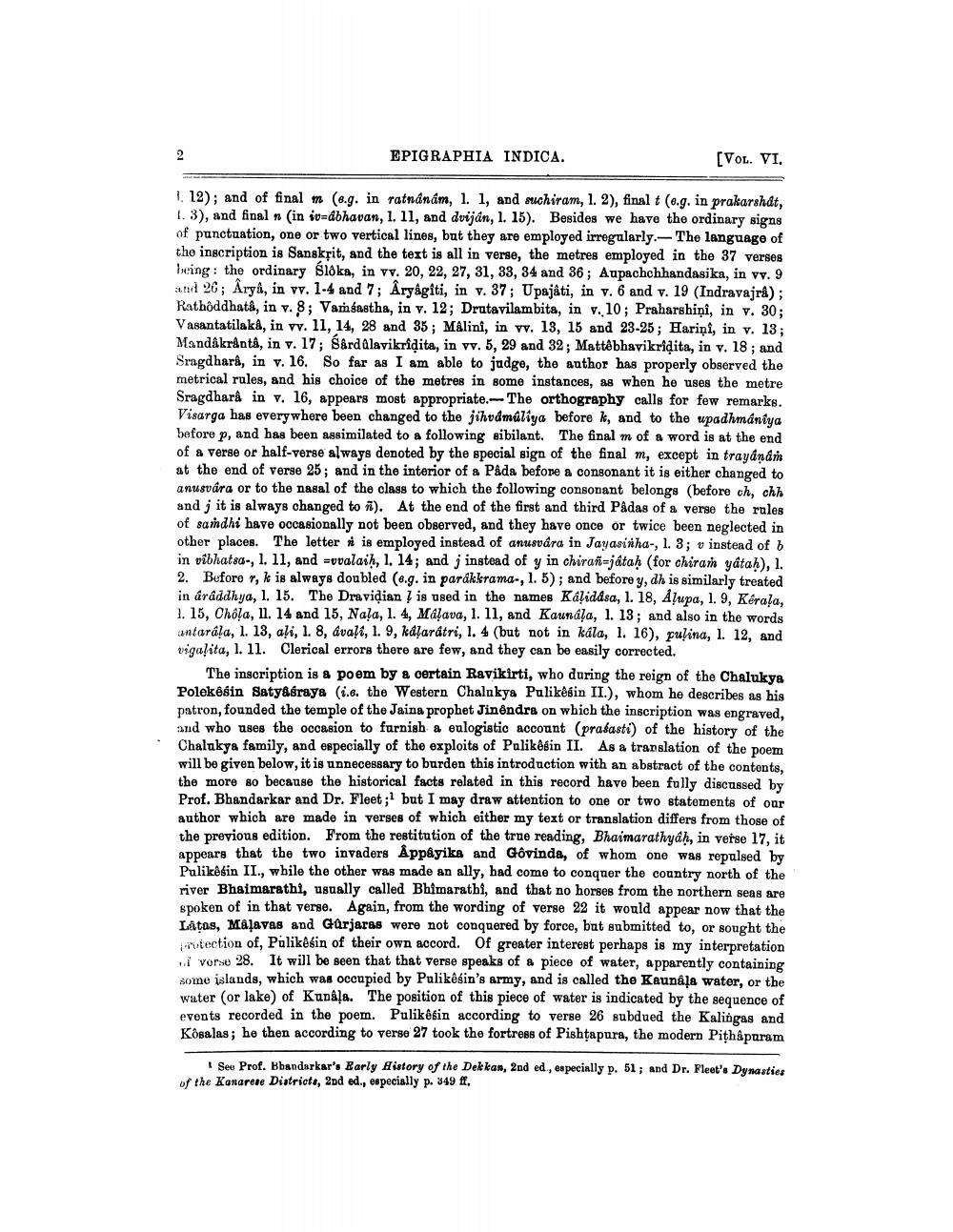________________
EPIGRAPHIA INDICA.
[Vol. VI.
1. 12); and of final m (o.g. in ratndnám, l. 1, and suchiram, 1. 2), final t (e.g. in prakarshdt, 1. 3), and final, (in iv-dbhavan, 1. 11, and dviján, 1. 15). Besides we have the ordinary signs of punctuation, one or two vertical lines, but they are employed irregularly.--The language of the inscription is Sanskrit, and the text is all in verse, the metres employed in the 37 verses being: the ordinary bloka, in vv. 20, 22, 27, 31, 33, 34 and 36; Aupachchhandasika, in vv. 9
26; Arya, in vv. 1-4 and 7; Aryagiti, in v. 37; Upajâti, in v. 6 and v. 19 (Indravajra); Rathôddhata, in v. 8; Vamgastha, in v. 12; Drutavilambita, in v. 10; Praharshini, in v. 30; Vasantatilaka, in vv. 11, 14, 28 and 35; Målini, in vv. 13, 15 and 23-25; Hariņi, in v. 13; Mandåkråntâ, in v. 17; Sard hlavikridita, in vv. 5, 29 and 32; Mattêbhavikridita, in v. 18; and Sragdhara, in v. 16. So far as I am able to judge, the author has properly observed the metrical rules, and his choice of the metres in some instances, as when he uses the metre Sragdhara in v. 16, appears most appropriate. The orthography calls for few remarks. Visarga has everywhere been changed to the jihvdmáliya before k, and to the upadhmaniya before p, and has been assimilated to a following sibilant. The final m of a word is at the end of a verse or half-verse always denoted by the special sign of the final m, except in trayandır at the end of verse 25; and in the interior of a Påda before a consonant it is either changed to anusvára or to the nasal of the class to which the following consonant belongs (before ch, chh and j it is always changed to 1). At the end of the first and third Padas of & verse the rules of sandhi have occasionally not been observed, and they have once or twice been neglected in other places. The letter is employed instead of anusvåra in Jayasinha-, 1. 3; v instead of b in vibhatsa-, 1. 11, and -vvalaih, 1. 14; and j instead of y in chiran-játah (for chiran yatah), 1. 2. Bufore , k is always doubled (e.g. in parákkrama-, 1. 5); and before y, dh is similarly treated in draddhya, 1. 15. The Dravidian / is used in the names Kaliddsa, 1. 18, Aļupa, 1. 9, Kerala, 1. 15, Chola, 11. 14 and 15, Nala, 1. 4, MAļava, 1. 11, and Kaunala, 1. 13; and also in the words antarala, 1. 13, ali, 1.8, dvall, 1. 9, kajarátri, 1. 4 (but not in kala, 1. 16), pulina, l. 12, and vigaļita, l. 11. Clerical errors there are few, and they can be easily corrected.
The inscription is a poem by a certain Ravikirti, who during the reign of the Chalukya Polek@gin Satyasraya (i.6. the Western Chalnkya Pulikesin II.), whom he describes as his patron, founded the temple of the Jaina prophet Jinêndra on which the inscription was engraved, and who uses the occasion to furnish a eulogistic account (prašasti) of the history of the Chalukya family, and especially of the exploits of Palikesin II. As a translation of the poem will be given below, it is unnecessary to burden this introduction with an abstract of the contonts, the more so because the historical facts related in this record have been fully discussed by Prof. Bhandarkar and Dr. Fleet;' but I may draw attention to one or two statements of our author which are made in verses of which either my text or translation differs from those of the previous edition. From the restitution of the true reading, Bhaimarathyah, in verse 17, it appears that the two invaders Åppâyiks and Gôvinda, of whom one was repulsed by Palikesin II., while the other was made an ally, had come to conquer the country north of the river Bhaimarathi, usually called Bhimarathi, and that no horses from the northern seas are spoken of in that verse. Again, from the wording of verse 22 it would appear now that the LATOS, MAļavas and Gurjaras were not conquered by force, but submitted to, or sought the
wtection of, Palikesin of their own accord. Of greater interest perhaps is my interpretation i vorse 28. It will be seen that that verse speaks of a piece of water, apparently containing some islands, which was occupied by Pulikêsin's army, and is called the Kaunâļa water, or the water (or lake) of Kunala. The position of this piece of water is indicated by the sequence of events recorded in the poem. Pulike in according to verse 26 subdued the Kalingas and Kosalas; he then according to verse 27 took the fortress of Pishtapura, the modern Pithapuram
Seu Prof. Bbandarkar's Early History of the Dekkas, 2nd ed, especially p. 51; and Dr. Fleet's Dynasties of the Kanareve Districts, 2nd ed., specially p. 349 ff.




